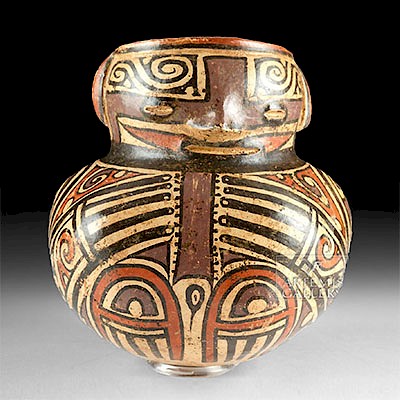Large Mayan Pottery Lidded Incensario - Ex Stendahl
Lot 76
About Seller
Artemis Fine Arts
686 S Taylor Ave, Ste 106
Louisville, CO 80027
United States
Selling antiquities, ancient and ethnographic art online since 1993, Artemis Gallery specializes in Classical Antiquities (Egyptian, Greek, Roman, Near Eastern), Asian, Pre-Columbian, African / Tribal / Oceanographic art. Our extensive inventory includes pottery, stone, metal, wood, glass and textil...Read more
Estimate:
$3,000 - $4,500
Absentee vs Live bid
Two ways to bid:
- Leave a max absentee bid and the platform will bid on your behalf up to your maximum bid during the live auction.
- Bid live during the auction and your bids will be submitted real-time to the auctioneer.
Bid Increments
| Price | Bid Increment |
|---|---|
| $0 | $25 |
| $300 | $50 |
| $1,000 | $100 |
| $2,000 | $250 |
| $5,000 | $500 |
| $10,000 | $1,000 |
| $20,000 | $2,500 |
| $50,000 | $5,000 |
| $100,000 | $10,000 |
| $200,000 | $20,000 |
About Auction
By Artemis Fine Arts
Nov 8, 2018
Set Reminder
2018-11-08 10:00:00
2018-11-08 10:00:00
America/New_York
Bidsquare
Bidsquare : Ancient / Ethnographic From Around The World
https://www.bidsquare.com/auctions/artemis-gallery/ancient-ethnographic-from-around-the-world-3598
Ancient art from Egypt, Greece, Italy and the Near East, as well as Asian, Pre-Columbian, Native American, African / Tribal / Oceanic, Spanish Colonial, Russian Icons, Fine art, much more! Artemis Fine Arts info@artemisgallery.com
Ancient art from Egypt, Greece, Italy and the Near East, as well as Asian, Pre-Columbian, Native American, African / Tribal / Oceanic, Spanish Colonial, Russian Icons, Fine art, much more! Artemis Fine Arts info@artemisgallery.com
- Lot Description
Pre-Columbian, southern Mexico and northern Central America, Mayan Territories, Late Classic period, ca. 550 to 900 CE. A large, impressive incensario, made of terracotta, composed of two pieces, a bowl and a lid. The bowl is round and studded with applied spikes so that it resembles a lychee (although its Mayan creators would not have been aware of the Chinese fruit). Two round perforations in its sides allowed fumes to escape. It stands on an integrated, slightly flaring cylindrical base, which is studded with openwork crosses and holes. The lid, with its rim and shoulder covered in similar spiked projections, fits nearly atop the rim of the bowl. The top of the lid has a tall, tiered conical projection that is open at the top. Size of lower part: 8.25" W x 12.75" H (21 cm x 32.4 cm); size of upper part: 7.5" W x 9" H (19 cm x 22.9 cm)
Incense played a major role in religious practice in Mesoamerica, from the Olmec onward. Many tombs are outfitted with incensarios and the items also seem to have been used in ceremonies by the living. The incense was made from copal, tree resin from the torchwood tree. By burning copal, Mesoamerican priests made an offering to the gods - for example, during an Aztec ceremony for the god Huitzilopochtli, the hummingbird-formed god of war, priests hoped that their prayers would be carried upward along with the wafting smoke and scent.
Provenance: collection of the late Alfred E. Stendahl, Stendahl Gallery, Los Angeles, California, USA
All items legal to buy/sell under U.S. Statute covering cultural patrimony Code 2600, CHAPTER 14, and are guaranteed to be as described or your money back.
A Certificate of Authenticity will accompany all winning bids.
We ship worldwide and handle all shipping in-house for your convenience.
#126348One side of bowl rim has losses along its edge and a slight, stable crack inward along the rim from its edge. The upper portion of the lid has been expertly repaired so that it is almost invisible.Condition
- Shipping Info
-
All shipping is handled in-house for your convenience. Your invoice from Artemis Gallery will include shipping calculation instructions. If in doubt, please inquire BEFORE bidding for estimated shipping costs for individual items.
-
- Buyer's Premium



 EUR
EUR CAD
CAD AUD
AUD GBP
GBP MXN
MXN HKD
HKD CNY
CNY MYR
MYR SEK
SEK SGD
SGD CHF
CHF THB
THB

















